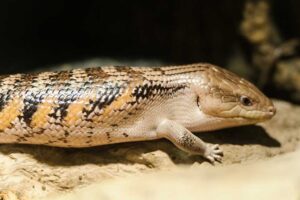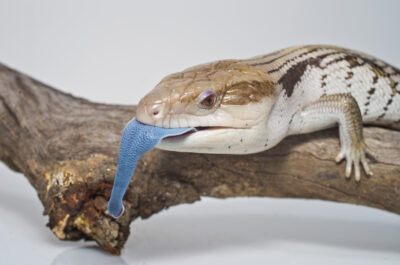If you’ve ever found yourself wondering, “Are Blue Tongue Skinks Friendly?” you’re in the right place. These unique reptiles have become increasingly popular in the world of exotic pets, captivating enthusiasts with their distinctive appearance and, of course, that intriguing blue tongue.
But when it comes to their demeanor, do these little buddies make good companions? Let’s dive into the fascinating world of Blue Tongue Skinks and explore whether they live up to their reputation as friendly and personable pets.
Are Blue Tongue Skinks Friendly?

Blue Tongue Skinks are generally known for being docile and relatively friendly reptiles, especially when compared to some other lizard species. However, individual temperament can vary, and factors such as handling, socialization, and their environment can influence their behavior.
With proper care and regular, gentle handling, Blue Tongue Skinks often become accustomed to human interaction. They may even show signs of recognizing their owners. It’s important to approach them calmly and avoid sudden movements to prevent them from feeling threatened.
It’s worth noting that while Blue Tongue Skinks are not aggressive by nature, they may display defensive behaviors if they feel cornered or stressed. These behaviors can include hissing, puffing up their bodies, or even opening their mouths to display their distinctive blue tongues.
If you are considering getting a Blue Tongue Skink as a pet, it’s crucial to research their specific care requirements, provide a suitable habitat, and interact with them in a way that promotes trust and reduces stress. Regular, positive interactions can contribute to the development of a well-socialized and friendly Blue Tongue Skink.
Importance of understanding their temperament
Understanding the temperament of Blue Tongue Skinks, or any pet for that matter, is crucial for several reasons:
- Handling and Interaction: Knowing the temperament of your Blue Tongue Skink helps you handle and interact with them appropriately. If they are generally calm and tolerant, you may feel more comfortable handling them regularly. On the other hand, if they are more skittish or prone to stress, you might adjust your approach to avoid causing them distress.
- Health Monitoring: Changes in temperament can sometimes indicate underlying health issues. If your usually docile Blue Tongue Skink becomes unusually aggressive or lethargic, it might be a sign that something is wrong. Being attuned to their usual behavior helps you notice any deviations that might require veterinary attention.
- Stress Reduction: Blue Tongue Skinks, like many reptiles, can experience stress, which can impact their overall well-being. Understanding their temperament allows you to create an environment that minimizes stress factors and provides them with a sense of security. This includes appropriate hiding spots, proper temperature and humidity levels, and a well-designed enclosure.
- Training and Enrichment: While reptiles may not be as trainable as some other pets, understanding their temperament can still help with basic training and enrichment activities. For example, if your skink is more food-motivated, you can use this to your advantage in training or providing mental stimulation through food-based enrichment.
- Bonding: Developing a bond with your Blue Tongue Skink is more likely when you understand their temperament. You can tailor your interactions to suit their comfort level, gradually building trust over time. This can lead to a more positive and enjoyable relationship between you and your pet.
Understanding the temperament of Blue Tongue Skinks is fundamental for their well-being, health monitoring, and building a positive relationship with them. It allows you to provide the best care possible and ensures a fulfilling experience for both you and your pet.
Blue Tongue Skink Characteristics
Blue Tongue Skinks (Tiliqua sp.) are a group of lizard species native to Australia, New Guinea, and parts of Indonesia. They are known for their distinctive blue tongues, which they use as a defense mechanism to deter predators. Here are some key characteristics of Blue Tongue Skinks:
- Size: Blue Tongue Skinks are relatively large lizards, with adult sizes ranging from 18 to 24 inches (45 to 60 cm) in length, depending on the species.
- Body Shape: They have a robust and flattened body, short legs, and a relatively short tail. The body shape is adapted for ground-dwelling.
- Scales: Their skin is covered in smooth, overlapping scales, which can vary in color and pattern depending on the species. Common colors include shades of brown, gray, and black.
- Head: Blue Tongue Skinks have a broad, triangular head with small eyes. Some species have distinctive markings on their heads.
- Tongue Color: One of their most notable features is their blue tongue. When threatened, they can stick out their tongue, which is brightly colored and often startles potential predators. The blue tongue serves as a warning signal.
- Lifespan: In captivity, Blue Tongue Skinks can live for 15-20 years or even longer with proper care.
- Diet: They are omnivores, and their diet includes a variety of insects, invertebrates, fruits, and vegetables. A well-balanced diet is essential for their health.
- Habitat: Blue Tongue Skinks inhabit a range of environments, from grasslands and woodlands to arid regions. They are ground-dwelling creatures and are often found in leaf litter or burrows.
- Temperature Requirements: Being ectothermic, Blue Tongue Skinks require a temperature gradient in their enclosure to regulate their body temperature. A basking spot with a temperature of around 90-100°F (32-38°C) and a cooler area in the low 70s°F (around 20°C) is typically provided.
- Behavior: Blue Tongue Skinks are generally known for their docile nature. While they may exhibit defensive behaviors if threatened, with regular and gentle handling, they often become comfortable with human interaction.
- Reproduction: They give birth to live young, and the gestation period is around three to four months. Litters typically consist of 5-25 offspring, depending on the species.
There are several species of Blue Tongue Skinks, each with its own specific characteristics and care requirements. Common species kept as pets include the Northern Blue Tongue Skink (Tiliqua scincoides intermedia) and the Indonesian Blue Tongue Skink (Tiliqua gigas). Proper research and understanding of the specific species you are keeping are crucial for their well-being.
Factors Influencing Blue Tongue Skinks Friendliness

The friendliness of Blue Tongue Skinks, or any animal, is influenced by a combination of genetic, environmental, and individual factors. Here are some key factors that can influence the friendliness of Blue Tongue Skinks:
- Species and Genetics: Different species of Blue Tongue Skinks may have varying temperaments. Additionally, individual genetic factors can play a role in determining a skink’s disposition. Some skinks may be naturally more docile, while others may be more skittish.
- Early Socialization: The way a Blue Tongue Skink is handled and socialized during its early stages of life can significantly impact its later behavior. Skinks that have positive interactions with humans from a young age are more likely to become comfortable with handling and show friendliness.
- Handling and Interaction: Regular, gentle handling helps build trust between the skink and its owner. Positive interactions contribute to a more friendly and tolerant disposition. On the other hand, rough or infrequent handling can make the skink more fearful or defensive.
- Environmental Enrichment: Providing a well-designed and enriched environment is crucial for the mental and physical well-being of Blue Tongue Skinks. A stimulating environment with hiding spots, proper substrate, and a variety of textures can contribute to a more content and less stressed skink.
- Temperature and Humidity: Maintaining appropriate temperature and humidity levels is essential for the health of Blue Tongue Skinks. Uncomfortable environmental conditions can lead to stress, affecting their behavior. A comfortable and stable habitat promotes a more relaxed and friendly demeanor.
- Health: A skink’s overall health can impact its behavior. Illness or discomfort may make the skink more irritable or defensive. Regular veterinary check-ups and a proper diet contribute to a healthier and happier pet.
- Individual Personality: Like any living being, Blue Tongue Skinks have individual personalities. Some may naturally be more curious and outgoing, while others may be more reserved. Understanding and respecting the individual nature of your skink can contribute to a positive relationship.
- Consistent Care: Providing consistent and proper care is crucial for building a trusting relationship with your Blue Tongue Skink. Regular feeding, cleaning, and attention to its needs help establish a routine and a sense of security.
While Blue Tongue Skinks are generally known for their docile nature, individual variations exist. Some skinks may be naturally more reserved, and it’s essential to respect their comfort levels and not force interactions.
Also, patience and positive reinforcement go a long way in fostering a friendly and trusting relationship with these reptiles.
Signs of a Friendly Blue Tongue Skink
A friendly Blue Tongue Skink will exhibit behaviors and body language that indicate a level of comfort and trust with its owner. Here are some signs that your Blue Tongue Skink is friendly:
- Approaching and Investigating: A friendly skink will often approach you willingly and show curiosity by investigating its surroundings, including your hands and arms. This behavior indicates a level of comfort and interest in interacting with you.
- Tolerant of Handling: A friendly Blue Tongue Skink will tolerate being handled without displaying defensive behaviors. This includes not hissing, biting, or attempting to flee when you pick it up. Instead, it may stay calm and relaxed in your hands.
- Relaxed Body Language: When a skink is comfortable and feels secure, its body language will be relaxed. This includes a lack of tension in the body, limbs, and tail. A friendly skink may rest in your hands without constantly trying to escape.
- Tongue Flicking: Blue Tongue Skinks use their tongues not only for defense but also for exploring their environment. If your skink is flicking its tongue while interacting with you, it may be a sign of curiosity rather than a defensive response.
- Closing Eyes: Closing their eyes is a behavior that indicates contentment and trust in reptiles. If your Blue Tongue Skink closes its eyes while being handled or during interactions, it’s a positive sign that it feels comfortable.
- No Defensive Postures: A friendly Blue Tongue Skink will avoid defensive postures such as puffing up its body, hissing, or opening its mouth aggressively. Instead, it may exhibit calm and neutral body language.
- Eating from Your Hand: Feeding time can be an excellent opportunity to gauge your skink’s friendliness. If it is comfortable eating from your hand without displaying signs of stress, it indicates a level of trust.
- Recognition and Bonding: Over time, a friendly Blue Tongue Skink may show signs of recognizing its owner. This could include approaching you when you enter the room or displaying a more relaxed demeanor in your presence.
The degree of friendliness can vary among individual skinks, and some may be naturally more reserved than others. Additionally, it’s crucial to be patient and allow the skink to set the pace for interactions. Consistent, positive handling and gentle care contribute to building trust and a friendly relationship with your Blue Tongue Skink.
Common defensive behaviors in Blue Tongue Skinks
While Blue Tongue Skinks are generally known for their docile nature, they may exhibit defensive behaviors when they feel threatened or stressed. It’s essential to recognize these behaviors to avoid causing further stress to the skink. Common defensive behaviors in Blue Tongue Skinks include:
- Hissing: When a Blue Tongue Skink feels threatened, it may emit a hissing sound. This is a warning signal to potential predators or perceived threats. Hissing is often accompanied by other defensive postures.
- Puffing Up: Blue Tongue Skinks have the ability to puff up their bodies to appear larger. This defensive behavior is an attempt to intimidate potential threats. The skink may arch its back and inflate its body to deter predators.
- Opening Mouth: In a more escalated defensive response, a Blue Tongue Skink may open its mouth wide. This is a threat display, and while Blue Tongue Skinks are not known for biting, they may try to intimidate by displaying their teeth and open mouth.
- Tail Wagging: Some Blue Tongue Skinks may wag their tails when they feel threatened. This behavior is not to be confused with the excited tail wagging seen in dogs. In Blue Tongue Skinks, tail wagging is a sign of agitation or stress.
- Freezing or Stiffening: When a Blue Tongue Skink feels threatened, it may freeze in place or stiffen its body. This behavior is an attempt to avoid detection by predators, and it often precedes more active defensive responses.
- Defensive Posture: Blue Tongue Skinks may adopt defensive postures, such as flattening their bodies against the ground. This posture can make them appear larger and more intimidating to potential threats.
- Flicking Tail: A skink may flick its tail when it’s stressed or feels threatened. This behavior is often accompanied by other defensive actions and can serve as a distraction or warning to potential predators.
- Avoidance or Retreat: In some cases, Blue Tongue Skinks may choose to avoid confrontation altogether. They may retreat to a hiding spot, burrow, or shelter if they perceive a threat. This behavior is a natural survival instinct.
It’s important to approach Blue Tongue Skinks with care and respect, especially if they are displaying defensive behaviors. Handling should be done gently, and if the skink exhibits signs of stress, it’s best to allow it some time to calm down in its enclosure.
Kindly know that consistent positive interactions can help build trust and reduce the likelihood of defensive behaviors over time.
Strategies for minimizing stress and encouraging trust

Minimizing stress and encouraging trust in Blue Tongue Skinks involves creating a comfortable and secure environment, along with positive handling and interactions. Here are some strategies to achieve this:
- Provide a Proper Habitat:
- Ensure the enclosure is appropriately sized with hiding spots and a proper substrate.
- Maintain stable temperature and humidity levels within the recommended ranges for the species.
- Use appropriate lighting, including a basking area with a heat source.
- Handle Gently and Respectfully:
- Approach the skink slowly and avoid sudden movements.
- Use a calm and gentle demeanor during handling.
- Start with short handling sessions and gradually increase the duration as the skink becomes more comfortable.
- Positive Reinforcement:
- Use positive reinforcement techniques, such as offering favorite foods, when interacting with the skink.
- Associate positive experiences with handling to create a positive association.
- Frequent but Short Interactions:
- Engage in frequent but short interactions rather than prolonged handling sessions.
- Regular, brief interactions can help the skink become accustomed to human presence without becoming stressed.
- Respect Their Space:
- Allow the skink to initiate contact when possible.
- Respect their hiding spots and avoid disturbing them when they choose to retreat.
- Hand-Feeding:
- Offer food from your hand to associate your presence with positive experiences.
- This can help build trust and make the skink more comfortable with your hands.
- Routine and Consistency:
- Stick to a consistent feeding and handling schedule.
- Establishing a routine can create a sense of predictability that can reduce stress.
- Avoid Overhandling:
- Be mindful of the skink’s comfort level and avoid overhandling, especially if it displays signs of stress.
- Allow the skink time to rest and acclimate to its environment.
- Provide Enrichment:
- Add environmental enrichment, such as different textures, climbing opportunities, and items to explore.
- A mentally stimulated skink is likely to be less stressed.
- Use Hide Boxes:
- Place hide boxes in the enclosure to give the skink a secure place to retreat when it feels stressed or threatened.
- Monitor for Signs of Stress:
- Be attentive to signs of stress, such as hissing, tail flicking, or defensive postures.
- If the skink shows signs of stress, give it time to calm down before attempting further interaction.
Remember that each Blue Tongue Skink is an individual, and the pace at which they become comfortable with handling may vary. Patience and a gentle, positive approach are key to fostering trust and reducing stress in these reptiles.

